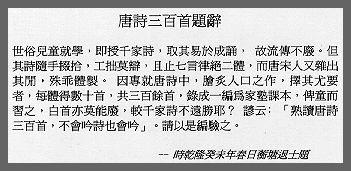


300 Tang PoemsIn Chinese literature, the Tang period (618-907) is considered the golden age of Chinese poetry. Tang Shi San Bai Shou [300 Tang Poems] is a compilation of poems from this period made around 1763 by Heng-tang-tui-shi [Sun Zhu] of the Qing dynasty. Sun's motivation for compiling the collection sprang from his dissatisfaction with the then popular textbook, the Qian Jia Shi [Poems by A Thousand Poets], an earlier collection from the Tang and Sung (960-1279) periods . Sun made his own selection of Tang poems based on their popularity and effectiveness in cultivating character. Because it represented equally well each of the classical poetic forms and because it represented the best works by the most prominent Tang poets, Sun's collection became a "best seller" soon after its publication. It has been used for centuries since to teach elementary students to read and write, and also in cultivating character. Sun's collection is still a classic today, its popularity undiminished. Nearly every Chinese household owns a copy of Tang Shi and poems from it are still included in textbooks and to be memorized by students. We would like to make this World Wide Web version of the poems as a testimony to its compiler's intent : " Learning Tang poems three hundred by heart, you can chant poems though you know not the art ." Chinese Text and English Translations There are 310 poems in the original collection of 300 Tang Poems, and additional poems were added later on. Our presentation contains 320 poems and is based on the Chinese electronic version created by Mr. Weichang Chan from the National Central University in Taiwan. The English translations are taken primarily from those in Witter Bynner's The Jade Mountain. Since there are only 310 poems in Bynner's collection, to complete our expanded collection of 320 poems we added three translations from Perspectives on the Tang, Yale University Press (nos. 190,191,193) ; and seven from 300 Tang Poems , the Commercial Press, HK (nos. 001, 003, 039, 040, 042, 083, 084). Some seventy-seven poets are represented here, as are these seven forms of Tang poetry:
View Chinese Text on the World Wide Web
In order to read the Chinese text , Chinese software with Big5 encoding system is
required. For detail information on how to read Chinese on the Web, please consult
Accessing Chinese Text on
the Internet .
Romanization and Word Division
We apply Pinyin system to romanizing all Chinese place and personal names. As to word
division, we separate personal surname from the given name, all given names and place
names are grouped in one word:
Zhang Jiuling Not Zhangjiuling or Zhang Jiu Ling Bibliographies
Readers who are interested in finding out more information on Chinese poetry or
translation of Chinese poetry may find this small selection useful:
1. Bynner, Witter. The Jade Mountain: A Chinese Anthology, New York : Alfred A. Knopf, 1929. 2. Davis, A.R. Tu Fu, New York : Twayne Publishers, 1971. 3. Gile, Herbert A. Chinese Poetry in English Verse, London : Bernard Quaritch, Shanghai: Kelly & Walsh, 1898.
4. Jenyns, Soame. Selections from the Three Hundred Poems of the T'ang Dynasty, London: John Murray, 1940. 5. Jenyns, Soame. A Further Selection from the Three Hundred Poems of the T'ang Dynasty, London: John Murray, 1944.
6. Wright, Arthur. Perspectives on the Tang , New Haven : Yale University Press, 1973.
7. Xu, Yuan-zhong. 300 Tang Poems: a new translation, Hong Kong: Commercial Press, 1987.  [University of Virginia | University Library | [Chinese Text Initiative Home Page] | |